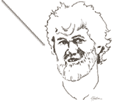




















|
|
Once Tim had the idea, he had to sit down and write the story. Zoom at Sea was written very quickly, in only 20 minutes. Usually, writing a story is a lot harder. The book was a success and Tim was asked to write more stories about this unusual cat.
Tim is usually up by 8:00 a.m. at the very latest. He goes up to the third floor, to his loft studio, and writes until noon. Then he has his lunch. After a 20-minute nap, Tim goes back to work until 3:00 or 4:00 p.m. He never writes at night, because he uses that time to be with his family or to sit in front of the fire and read.
|
"Usually I know, when I sit down, exactly what I'm going to start writing. Of course, as soon as I start, the story goes wherever it wants, which is the fun of writing." (Tim Wynne-Jones in a letter written for the site)
|
When he's writing, Tim is very strict about one thing. If he's not actually writing, he doesn't stay at his desk. He says he thinks better on his feet, so he gets up and does something else. He might do the dishes or go for a walk.
|
"I knew there were at least two places. I knew Zoom had to go up to the North, which would be in the attic, and he had to go south to Egypt, which would be the basement." (Emergency Librarian. 15:3, January-February 1988, p. 59)
|

Tim says that Zoom Upstream was very hard to write. In the story, Zoom falls asleep in the garden and wakes up to find his friend, Maria, gone. He follows her muddy footprints inside her house to the library.
Tim tried leading Zoom to other places. He knew in this story that Zoom would have to go down. In the first book, Zoom entered the sea from the first floor. In the second book, Zoom climbed to the attic. The only place left for him to go in the third book was down.
The question Tim had to answer was how would Zoom go down? He didn't want Zoom to disappear into a closet, and simply taking the stairs down to the cellar seemed too obvious. Then inspiration hit. Tim thought of having Zoom find his way behind a book on a shelf. This was because he had the idea that books were like doorways, or thresholds, leading to different places.
|
"Every book is a Threshold. But it must be taken from the shelf. In Zoom's case, the shelf is high and the book is a step-up." (CCL. No. 48, 1987, p. 53)
|

Zoom climbs into the place on the shelf where the book was and finds a staircase of books leading down. Though a little frightened, Zoom goes down the stairs. He comes to a river that leads to somewhere he's never been before – ancient Egypt.
Top of Page
|